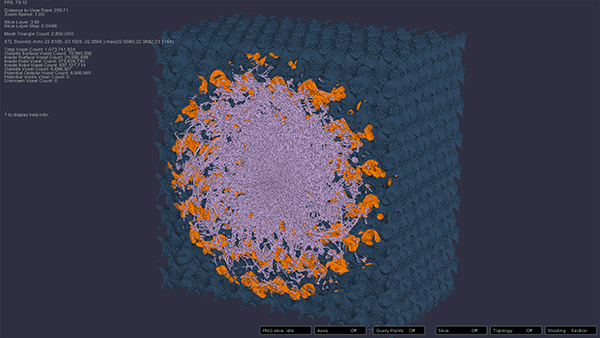
In October 2020, Dyndrite released a voxel toolpath programming API, aiming at attracting the voxel-based additive manufacturing software developers. Image courtesy of Dyndrite.
Latest News
March 3, 2022
This week, Dyndrite, an additive manufacturing (AM) software developer, held a Digital Manufacturing Investor Day conference online to discuss the technology's shift from rapid prototyping to mass manufacturing.
Haershil Goel—a mathematician, engineer, and entrepreneur—founded and launched Dyndrite in 2016. The firm is shepherded by, among others, Google Gradient Ventures and Carl Bass, former CEO of Autodesk. The company's first product is the Dyndrite engine, released in March 2019. In October 2020, HP became the first commercial licensee, incorporating it into the HP Universal Build Manager.

New AM Business Models
Lou Rassey, CEO of Fast Radius, was part of the Dyndrite Manufacturing Investor Day presentation lineup. He describes his firm as “a cloud manufacturing company.” He explained, “We are building a suite of tools to support our customers across the journey of designing, making, moving and managing parts. Those tools include design for manufacturability tools, cost analytics tools, software driven insights ... we also provide a software-driven platform for ordering parts.”
The 3D printing industry did not shrink during the COVID crisis. Quite the opposite. According to the 2021 industry report by Wohlers Associates, “the additive manufacturing industry grew by 7.5% to nearly $12.8 billion in 2020, despite the ongoing global COVID-19 pandemic.”
“Gven the significance and the importance of the industry, the size of the industry, the wave of innovations coming up, it just became very clear that there was an opportunity to create a new type of platform,” noted Rassey.
Shri Shetty, CEO of the medical-focused 3D printing firm PrinterPrezz, explained his firm is “taking existing technologies from companies like GE, 3D Systems, EOS, and oiling them with a semiconductor digital backbone, and creating an end-to-end ecosystem to take [medical] devices to market faster at higher yields, lower cost, and better tailored for the patient outcomes.”
PrinterPrezz is not building its own printer line. By assembling an infrastructure with hardware already approved for medical use, it bypasses the regulatory roadblocks.
The emergence of firms like Fast Radius and PrinterPrezz point to new business models. No longer confined to simply offering printing services, some may begin offering AM ecosystems complete with online tools to manage the entire process for mass-manufacturing AM parts reliably in large volume.
In the panel discussion following the talks, Christian Hartenberger, BNP Paribas, said, “People don't want a gadget in a box; they want a holistic solution.”
The Role of AM Software
Scalability and consistency are important considerations as many firms are now looking at AM to produce not only one-of-a-kind prototypes but standard end-use parts that must survive for a specific lifespan. Geoffrey Doyle, Uniformity Labs, noted, “I think there's still a question mark over some of the the cost structure of the machines and the repeatability of the machines.”
In recognition of AM's growing importance, CAD modeling software vendors have been adding modeling and analysis tools for creating topology optimized for 3D printing, but their ease of use and accessibility remain an open question.
Tali Rosman, Xerox Elem Additive, said, “The existing solutions are too cumbersome for users ... Thinking from a customer's perspective, they don't really care about all of our internal issues and all of our formats ... They just want an easy solution to go from an optimized design to a part in their hand as easy and as fast as possible without needing 10 different licenses and switching formats.”
Avi Reichental, Nexa3D, noted, “Design for additive goes beyond machine functionality. It really brings in a completely new design thinking. It's not optimization for a specific machine. It enables a combination of parts; it enables lightweighting; it enables the creation of geometries that could not be traditionally manufactured.”
Recently, Dyndrite released an advanced toolpath programming API. The company ssaid it would enable “true 3D Volumetric Part Segmentation for detection of upskins, downskins, inskins, and features.”
For more on Dyndrite Manufacturing Investor Day, visit the event home page here.
Dyndrite is delighted to announce @3dadept, @3dpbm, @DEVELOP3D, @Metal AM, and @PeerlessMedia as media sponsors for Digital Manufacturing Investor Day (DMID) 2022. A huge thank you for their help and support! Register now: https://t.co/aqmVpxk1pI #3dprinting #dmid #dmid2022 pic.twitter.com/Tu5o9NRVnH
— Dyndrite (@Dyndrite) February 15, 2022
Subscribe to our FREE magazine, FREE email newsletters or both!
Latest News
About the Author
Kenneth Wong is Digital Engineering’s resident blogger and senior editor. Email him at [email protected] or share your thoughts on this article at digitaleng.news/facebook.
Follow DE





